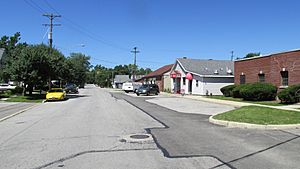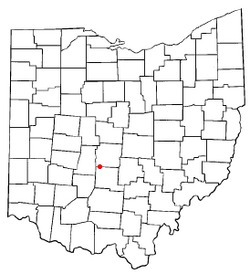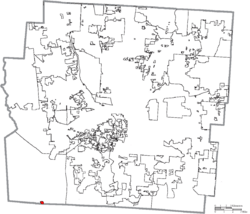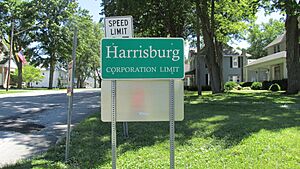Harrisburg, Ohio facts for kids
Quick facts for kids
Harrisburg, Ohio
|
|
|---|---|
|
Village
|
|

Looking north on High Street in Harrisburg
|
|

Location of Harrisburg, Ohio
|
|

Location of Harrisburg in Franklin County
|
|
| Country | United States |
| State | Ohio |
| Counties | Franklin, Pickaway |
| Area | |
| • Total | 0.15 sq mi (0.40 km2) |
| • Land | 0.15 sq mi (0.40 km2) |
| • Water | 0.00 sq mi (0.00 km2) |
| Elevation | 797 ft (243 m) |
| Population
(2020)
|
|
| • Total | 315 |
| • Estimate
(2023)
|
309 |
| • Density | 2,032.26/sq mi (784.61/km2) |
| Time zone | UTC-5 (Eastern (EST)) |
| • Summer (DST) | UTC-4 (EDT) |
| ZIP code |
43126
|
| Area code(s) | 614 and 380 |
| FIPS code | 39-33740 |
| GNIS feature ID | 2398252 |
Harrisburg is a small village located in the state of Ohio, USA. It is found in both Franklin and Pickaway counties. In 2020, about 315 people lived there.
Contents
A Look at Harrisburg's History
Harrisburg was started in 1836 by a person named Joseph Chenowith. Before it became a village, the area was known as Darby Cross Roads. The village was named after Harrisburg, Pennsylvania.
A post office, first called Big Darby Post Office, opened nearby in 1834. Its name changed to Harrisburgh Post Office in 1835. For a short time in 1836, the post office closed, but it quickly reopened. The spelling of "Harrisburg" was officially set in 1893.
From its beginning in 1836, Harrisburg was a busy place. About 30 families lived there at first. By 1858, the population grew to 115 people. By 1900, it was around 200, and by 1908, it was estimated to be 300 people.
Where is Harrisburg Located?
Harrisburg is a small village. It covers an area of about 0.40 square kilometers (0.15 square miles). All of this area is land.
Who Lives in Harrisburg?
| Historical population | |||
|---|---|---|---|
| Census | Pop. | %± | |
| 1850 | 109 | — | |
| 1860 | 140 | 28.4% | |
| 1870 | 153 | 9.3% | |
| 1880 | 186 | 21.6% | |
| 1890 | 211 | 13.4% | |
| 1900 | 247 | 17.1% | |
| 1910 | 286 | 15.8% | |
| 1920 | 258 | −9.8% | |
| 1930 | 276 | 7.0% | |
| 1940 | 294 | 6.5% | |
| 1950 | 344 | 17.0% | |
| 1960 | 359 | 4.4% | |
| 1970 | 556 | 54.9% | |
| 1980 | 363 | −34.7% | |
| 1990 | 340 | −6.3% | |
| 2000 | 332 | −2.4% | |
| 2010 | 320 | −3.6% | |
| 2020 | 315 | −1.6% | |
| 2023 (est.) | 309 | −3.4% | |
| U.S. Decennial Census 2020 | |||
Population in 2010
In 2010, there were 320 people living in Harrisburg. These people lived in 138 homes. Most of the people (96.9%) were White. A small number were African American, Native American, or Asian. About 0.3% of the population was Hispanic or Latino.
The average age of people in the village was about 44.7 years old.
- About 19.1% of residents were under 18 years old.
- About 7% were between 18 and 24 years old.
- About 24.8% were between 25 and 44 years old.
- About 35% were between 45 and 64 years old.
- About 14.4% were 65 years or older.
The village had a nearly equal number of males and females. About 50.9% were male and 49.1% were female.
See also
 In Spanish: Harrisburg (Ohio) para niños
In Spanish: Harrisburg (Ohio) para niños


